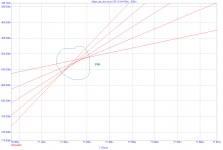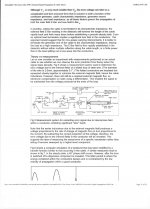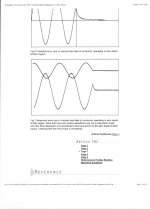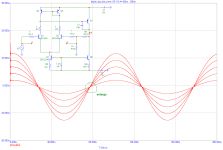the scope measurement was more than suspicious, without any descriptions of X and Y axis
Were you aware that the test wire was magnetic steel and not copper?
edit: Page 63, first two paragraphs after "theory vs measurements". Note also that there is no mention of the internal inductance of the magnetic wire nor it's mu (JC informed me it was 100), so no consideration of the wire permeability's effect on the per length inductance. That would be 100 times 15 nH per foot, or 1.5 uH per foot. Skinning would reduce that, however without knowing the precise mu nor the precise conductivity, calculation is not possible. Measurement certainly is.
jn
Last edited:
Were you aware that the test wire was magnetic steel and not copper?
jn
Oh no, I was not ......
It was mentioned in the text, in order to 'bring out' the problem on a scope screen. Try that with moderate distortion sometime. '-)
Also, the Hawksford distortion was emulated in MathCad. Same approximate results.
PMA, would you tell Scott, that I agree that YOUR model of the CTC Blowtorch line stage is adequate for criticism re FM distortion?
Do YOU, PMA, see any potential problems with FM distortion with that circuit? Ron and I can't as yet.
Also, the Hawksford distortion was emulated in MathCad. Same approximate results.
PMA, would you tell Scott, that I agree that YOUR model of the CTC Blowtorch line stage is adequate for criticism re FM distortion?
Do YOU, PMA, see any potential problems with FM distortion with that circuit? Ron and I can't as yet.
This reminds me of the mu-metal cables that were in circulation for a while. It shows that if you work hard enough at it (like the capacitor microphone cables from Audioquest) you may be able to create some cables with, under worst-case conditions, audible effects (and certainly measurable ones).Were you aware that the test wire was magnetic steel and not copper?
jn
But I think it's pretty easy to make the effects negligible. Low source Z for a start, and if high frequency (way beyond audio band) instability is a concern, a little Zobel here and there.
I like some highend interconnects, but primarily because they use good RCA plugs, those connectors being the biggest mistake introduced into external audio connections until the advent of 3.5mm stereo miniplugs
Does anyone have a copy of the Audio magazine article by Greiner about cables? I recall I was slightly irritated by his not disclosing details of some super-special differential amp used in his tests. But one of the conclusions iirc was that keeping speaker cables short was a good idea. In any event, ultimately he was convinced that everything he noted was well-explained by standard classical electrodynamics.
All this voodoo stuff that clutters the shelves of electronic audio is based on pseudo-scientific arguments lying on some analogy. By example, because everybody remembered the microphonic effect of tubes, it is easy to sell golden cones, pretending they cure those so calling microphonic effects even on solid states devices.
The fact that, even in hitting the preamp with a hammer does not produce any audible noise in the enclosure will not stop the audiophile.
After hours of listening comparisons, he will convince himself of the real benefit of those cones, and be very proud of his listening expertise and knowledge.
It makes-me remember, in France, this fashion for a conducting liner rubber band that hung behind the car, rubbing on the ground. It was designed to eliminate static charges, they said responsible of "car sickness". You could see half the cars equipped with this thing...
Meanwhile, the technicians worked to seal the cockpit and the engine in order to isolate passengers from gasoline and oil vapors.. I do not see any more those rubber band since decades.
The fact that, even in hitting the preamp with a hammer does not produce any audible noise in the enclosure will not stop the audiophile.
After hours of listening comparisons, he will convince himself of the real benefit of those cones, and be very proud of his listening expertise and knowledge.
It makes-me remember, in France, this fashion for a conducting liner rubber band that hung behind the car, rubbing on the ground. It was designed to eliminate static charges, they said responsible of "car sickness". You could see half the cars equipped with this thing...
Meanwhile, the technicians worked to seal the cockpit and the engine in order to isolate passengers from gasoline and oil vapors.. I do not see any more those rubber band since decades.
Last edited:
As often, the question asked by sir March:However, I have simulated the PIM in a very different circuit ....
"Can we modify a circuit to change its open-loop BW at a modulated rate of our choosing?" make sense with its undercurrent.
I will try to add a varicap as the miller cap of a circuit, in order to ear exactly the audible effect of PIM. We all know how sound clippings. Did we know exactly how are sounding those PIM at hight levels, in order to discriminate them and know their order of effect?
It will be a long experiment, with various open loop FC, and various speeds of modulation.
"May i introduce myself ? My name is PIM. My enemies call-me: Awful PIM."
Last edited:
For a long time car tyres have been made slightly conductive to reduce the problem of static charge. As a car is quite a good Faraday cage anyone inside it will be completely unaware of any external charge build-up anyway. The problem would occur when entering or leaving the car. Fueling has its own methods for dealing with static.Esperado said:I do not see any more those rubber band since decades.
PMA, can you show or tell us about your 'completely different circuit'? The one that generated obvious PIM?
This one:
Attachments
Any referee capable of examination at that level would have checked either the box [acceptable for publication after correction of specific errors]....or the box [not acceptable due to catastrophic errors].
I would suspect the latter- that's what I meant by "having been vetted by a referee." So now what? Oh, audiophile magazines! They pay, they promote my name, and they and their audiences LOVE entertaining pataphysics! It's a no-brainer.
We can suppose the effects of those PIM. We know how our ears are tolerant in regard to absolute tones, when we know how difficult it is to perfect tune a guitar. We know too the vibrato effects. While we don't know the effects of very high speed vibratos.
Anyway, when we measure a total distortion with a distortiometer, they are part of the 0.001% result, Don't they ?
Anyway, when we measure a total distortion with a distortiometer, they are part of the 0.001% result, Don't they ?
Last edited:
PMA, here is some input for discussion of the Hawksford problem: Please note details, such as use of iron for the test, inductance cancellation circuit, emulation, etc.
When I worked in a High Power Testing Lab some 30 years ago, measuring technicians made a similar mistake. They put the coax cables into iron tube, hoping they would eliminate magnetic field interference. The opposite was truth, of course, especially due to intensity of magnetic field during high voltage circuit breakers short circuit tests. Very similar effect. I only hope M. H. had not done this intentionally to mystify the readers.
Reason why i saved my "Ruber band" money at this time, and used-it to invite some pretty girl to dinner, hoping she will come, later, in my home Faraday cage.As a car is quite a good Faraday cage anyone inside it will be completely unaware of any external charge build-up anyway.
"I do not like girls who sleep the first night. They require you to wait all afternoon."
Last edited:
PMA, here is some input for discussion of the Hawksford problem: Please note details, such as use of iron for the test, inductance cancellation circuit, emulation, etc.
Cool. I only have scans of the article.
The most important note of all to the waveforms. The "error" is the classic error of ignoring the collapse of the magnetic field of the wire when a signal is abruptly changed. I see this error committed by many rather good test engineers who have years of experience. To see that Hawksford succumed to the same error just means he's human..
jn
Shame on you, Jneutron. You don't have any respect for the star system. You will have no luck to be a member of AES.To see that Hawksford succumed to the same error just means he's human..
"May i introduce myself ? My name is PIM. My enemies call-me: Awful PIM."
Monty Python- Tim, the Enchanter - YouTube
Cool. I only have scans of the article.
The most important note of all to the waveforms. The "error" is the classic error of ignoring the collapse of the magnetic field of the wire when a signal is abruptly changed. I see this error committed by many rather good test engineers who have years of experience. To see that Hawksford succumed to the same error just means he's human..
jn
Doesn't the suddenly unapplied signal have enegy at all frequencies, gee if I look close I think it looks like a little down staircase.
- Status
- Not open for further replies.
- Home
- Member Areas
- The Lounge
- John Curl's Blowtorch preamplifier part II



